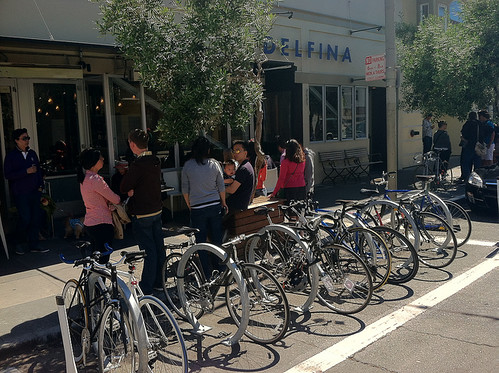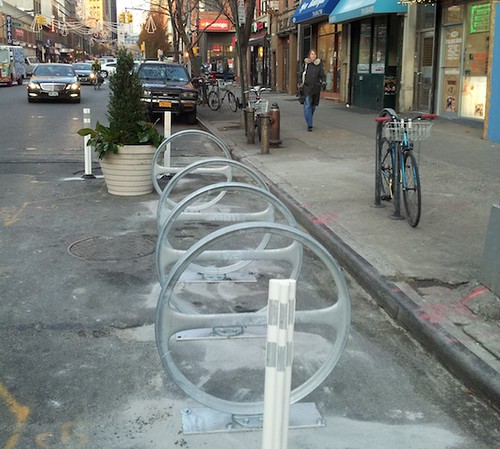Why Chicago Is Lagging Behind Other Cities on Bike Parking Corrals
4:20 PM CST on March 8, 2013
Not surprisingly, Portland, Oregon, leads the nation in on-street bike parking corrals, with 97 installed since 2004 and about 20 more going in each year. San Francisco, which installed its first corrals on Valencia Street in May 2010, now has 32 of them. New York City, which began installing corrals in August 2011, currently has 12. But Chicago, which debuted its first on-street racks, in front of Wicker Park’s Flat Iron Building, a month before New York, only has four corrals so far, with a fifth slated for Logan Square’s Revolution Brewing this spring.
The Chicago Department of Transportation’s forward-thinking Commissioner Gabe Klein has been an outspoken proponent of the corrals, which can fit up to 12 bike in one car space, because they promote cycling, clear space on sidewalks and make businesses more visible. “Studies have shown that having bike facilities in front of your business can increase business by double digits,” Klein said at the Flat Iron ribbon cutting, promising more on-street corrals around the city soon. So why, 19 months later, does Chicago only have one-third as many as New York and one-eighth as many as San Francisco?
The difference is funding. CDOT recently used a federal and local Congestion Mitigation and Air Quality grant to hire Tony Giron part-time as bike parking corral program manager, with the goal of arranging 20 installations by September. They’ve created an attractive brochure to promote the on-street racks and Giron’s services to business owners and community organizations. But while the city governments in Portland, San Francisco, and New York pay for the materials and installation for the corrals, Chicago does not. The on-street racks installed and planned so far have been bankrolled by chambers of commerce, Special Service Areas – a district where an additional property tax pays for extra services – and/or business owners.
Therefore, Giron, who was promoted to the full-time position of bike parking manager [a job John Greenfield held in the early 2000s] on Monday, responsible for sidewalk rack installations as well, has a daunting task. Not only does he need to convince merchants and community leaders that swapping car spaces for bike parking is a good idea, but he has to persuade them to pay for the corrals. The brochure estimates the equipment and installation costs for a five rack, ten-bike corral at $2,500-3,000, plus annual expenses of $75 for a public way permit and $800 for winter removal and spring replacement for racks located on snow routes.
In contrast, the city of New York pays for their corrals, estimated at $3,000 each for materials and labor, using 80% federal grants and 20% municipal funds, according to spokesman Scott Gastel. San Francisco also provides corrals, valued at about $2,500, at no cost to businesses that apply for them, with funding coming from city, county and regional sources plus federal Transportation Enhancement grants, said spokesman Paul Rose. In Portland, where corrals cost about $2,600, the city has bankrolled them, mostly via a bicycle parking fund that developers pay into when they cannot install short-term bicycle parking on their property, according to bike coordinator Roger Geller.
Asked why his city chooses to invest in bike corrals, Portland Bureau of Transportation spokesman Dan Anderson said, “Providing ample, convenient and secure bicycle parking serves the ever-growing number of people who bike in Portland. Bicycle parking infrastructure is a key part of any bikeway network and integral in Portland’s plan to increase the share of trips taken by bike.”
Chicago has the same goals, so why isn’t our city lining up funding for on-street bike corrals instead of trying to convince businesses and community organizations to pay for them? Since the 1990s, CDOT has installed over 12,000 racks on sidewalks using CMAQ grants, and the sidewalk rack construction contract is currently in year three out of five, Giron said. “When the contract went out to bid, the city did not foresee the need for bike corrals and so it was never added as a line item. I imagine the city will add bike corrals to the next contract that goes out to bid in a couple years.”
In the meantime, Giron is trying to figure out a way to temporarily modify the contract to allow for bike corrals to be installed, perhaps in conjunction with bike lane projects. “I want corrals to be a key element when CDOT is designing a ‘complete street,’” he explained. Hopefully he’ll succeed, which would make his assignment to get 20 corrals installed in six months a much more realistic mission.
In addition to editing Streetsblog Chicago, John writes about transportation and other topics for additional local publications. A Chicagoan since 1989, he enjoys exploring the city on foot, bike, bus, and 'L' train.
Stay in touch
Sign up for our free newsletter
More from Streetsblog Chicago
Today’s Headlines for Thursday, April 25
It’s electric! New Divvy stations will be able to charge docked e-bikes, scooters when they’re connected to the power grid
The new stations are supposed to be easier to use and more environmentally friendly than old-school stations.






